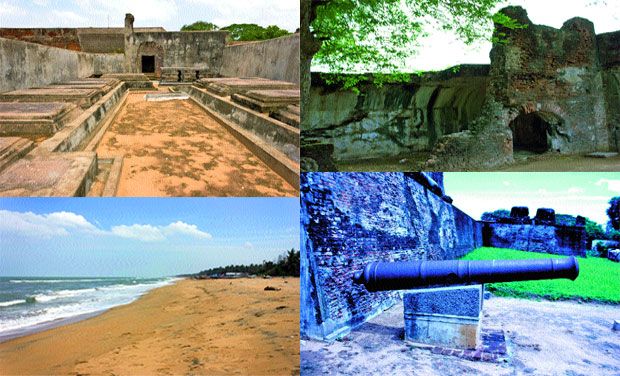
Sadras:
The serene fort of Sadras stands strong, yet fragile in all its ruined glory. Not many would know that it exists in the sleepy little town of Kalpakkam — who would notice it when there is a nuclear power plant coming up two kms away.
Sadras is a quiet fishing hamlet and the fort was one of the seats of power of the Dutch who docked there in the early 17th century. They, like the other Europeans, landed here to pursue their interests in trade. The fort happened to be standing at the heart of a battlefield, with the Dutch, Portuguese, French and British fighting to establish their monopoly here. It’s no surprise then that the fort retains a crippled magnificence.
Thus, I stand among the ruins of the fort of Sadurangapattinum, as it was called then, before it was anglicised to ‘Sadras’ by the Europeans. A white tomb and cannon adorn the entrance to the cemetery, the warehouses have been restored by the Archaeological Survey of India and the fort walls are charred, yet red.
Story has it that the battle of Sadras was fought between the British and Dutch. After suffering a brief setback in the first war the British took over in the early 19th century, razing the fort to the ground, firing cannon from the sea.
So what drew the Europeans to this calm village? This place was under the stronghold of the Cholas and later became a part of the Vijayanagara Empire, it being a bustling hub of trade and a weaving centre, well known for its muslin export to the Europeans.
The keeper of the fort tells me all about the graves and their inscriptions. Further inside, in a room assumed to be a secret chamber or dungeon, there is a gaping hole where the central structure has caved in, making way for the sun to light up the room.
We step further into the fort, the ruins in red and black standing out against the tall green weeds that are creeping up everywhere. Beyond the warehouses I climb the ramp, leading to the roof of the rooms, which is the highest point of the fort. I stand and listen to the distant roar of the sea, stretching out like a blanket far beyond the horizon.
I can see in my mind’s eye what the red structure must have looked like in all its original splendour. A fort, marked with triangular, yet rook-like pillars, with cannon and battlements at its corners; beautifully carved archways in white and red, leading to the warehouses and chambers of the settlers beyond, abuzz with activity. The lapping of the waves pulls me back to the present. It’s time to leave the past and enjoy the beach in front of me.
source: http://www.deccanchronicle.com / Deccan Chronicle / Home> Lifestyle> Travel / Deccan Chronicle / by R. Supraja / May 12th, 2014